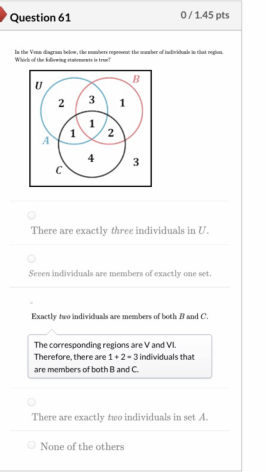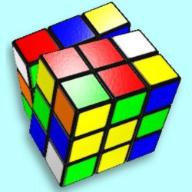Did I get the right answer to this math problem?
2019-12-09 1:46 am
I chose none of the others

回答 (4)
2019-12-09 2:24 am
If I HAD to pick, I'd say
>>>>>>>>>>>>>>>"Seven individuals are members of exactly one set"
Note this doesn't say "same set". It just says, you can find seven individuals of whom every one is a member of exactly one set.
Let's elaborate.
2 individuals in only A.
1 individual in only B.
4 individuals in only C.
We found 7 individuals that are members of exactly one set.
Also note it doesn't have to be exactly 7 either. If we found 10, the statement would still be true.
But the truth is, I just don't know. It could be "None of the others" and I'm crossing my fingers for you if this was on a test :)
English is not made for set theory but for bar fights. You can't unambiguously define something in only a single short sentence. This is what mathematical symbols are for, and words aren't.
>>>>>>>>>>>>>>>"Seven individuals are members of exactly one set"
Note this doesn't say "same set". It just says, you can find seven individuals of whom every one is a member of exactly one set.
Let's elaborate.
2 individuals in only A.
1 individual in only B.
4 individuals in only C.
We found 7 individuals that are members of exactly one set.
Also note it doesn't have to be exactly 7 either. If we found 10, the statement would still be true.
But the truth is, I just don't know. It could be "None of the others" and I'm crossing my fingers for you if this was on a test :)
English is not made for set theory but for bar fights. You can't unambiguously define something in only a single short sentence. This is what mathematical symbols are for, and words aren't.
2019-12-09 2:22 am
The intro paragraph of the question is completely illegible, so I hope it is not important.
The convention is for U to be the universe in which all of the elements reside. If those digits represent the number of elements in each region, then there are 17 in U, and the first option is not true.
The sets to which the second option refers are presumably A, B, and C (not U). There are two elements in A only, one in B only, and four in C only. That makes seven in total, so I would take the second option as being correct. All of those intersections also are sets, but they are not labeled as such.
The number of elements in both B and C is 1 + 2 = 3, so the third option is incorrect.
The number of elements in set A is 2 + 3 + 1 + 1 = 7, so the fourth option is incorrect.
The fifth option is none of the others. I suppose that means none of the other options above, so this one is incorrect, since option two seems to hold up.
The convention is for U to be the universe in which all of the elements reside. If those digits represent the number of elements in each region, then there are 17 in U, and the first option is not true.
The sets to which the second option refers are presumably A, B, and C (not U). There are two elements in A only, one in B only, and four in C only. That makes seven in total, so I would take the second option as being correct. All of those intersections also are sets, but they are not labeled as such.
The number of elements in both B and C is 1 + 2 = 3, so the third option is incorrect.
The number of elements in set A is 2 + 3 + 1 + 1 = 7, so the fourth option is incorrect.
The fifth option is none of the others. I suppose that means none of the other options above, so this one is incorrect, since option two seems to hold up.
2019-12-09 1:52 am
There are 3 individuals in U (people not in A, B or C) not 2 and all the other statements are false too.
You are correct...well done!
You are correct...well done!
2019-12-09 1:51 am
The statement about there being exactly 3 individuals in U seems correct, but it isn't. The universal set (U) would be the sum of every number in the Venn diagram. The 3 outside the circles are just those that aren't in A, B or C. But everyone is A, B or C is also in the universal set.
Answer:
None of those statements are correct. So you are correct in picking 'None..."
Update:
I revise my answer and go with RealPro's interpretation on statement #2. I think in retrospect, that's the one I would pick.
Answer:
None of those statements are correct. So you are correct in picking 'None..."
Update:
I revise my answer and go with RealPro's interpretation on statement #2. I think in retrospect, that's the one I would pick.
收錄日期: 2021-04-24 07:40:36
原文連結 [永久失效]:
https://hk.answers.yahoo.com/question/index?qid=20191208174641AAY9UTC

